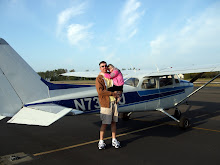
1.5hrs – Everything in the book (it seemed)
We began with reviewing stalls, both power-on, power-off, and while in a turn. All are really a non-event (with 3000ft of air below you anyway).
Next up were steep turns, which have really shaped up after the solo time I spent last week practicing.
Ground reference was easy with winds of about 4kts, but probably still need a little work on a day that’s blowing a bit more.
My first engine out of the day went very well. I trimmed for best glide (68kts), found a nice large field, and settled into a nice easy descending turn into a downwind leg. On final at 500ft I had the field made, but saw that an actual landing could be a bit sketchy as a string of light power lines came into view. Power lines a very difficult to see from the air.
My second engine out also went well, and had just noted and airport we’d not been to in Newberg (Chehalem – 17S) prior to my instructor pulling the power out. On short final I had the runway made, so it became a go-around practice.
After we climbed out from Chehalem, my CFI pulled the throttle back to 1800 to simulate a partial power situation. 2S6 (Sportsman) was now close, and I could maintain altitude, so the simulated partial power became a simulated stuck throttle. This was a first for me, and actually really fun to control the descent and airspeed with changes in pitch and/or adding or removing flaps. If the thottle was actually stuck, or the for some reason not adjustable, you'd pull the mixure out once the landing is assured. In a simulation, the throttle is pulled back to idle. On final I was a little high, and could also have controlled the descent more with a slip, but slips are still a weak spot.
While at Sportsman we practiced simulated short and soft field takeoffs and landings. The weak spot here is short field landings.
Next on the list was hood work. My instrument scan has improved, making turns climbs and descents much easier. Recovery from unusual attitudes went pretty well, as did flying directly to the Newburg VOR. The process for recovery from unusual attitudes involves closing your eyes with your head down while the instructor makes a series of pitch and bank changes to throw your sense of balance off. You then open your eyes and recover to straight and level flight using only instruments (you have the "hood" on, which limits you view).
The feeling of being thrown around a bit with your eyes closed, and your head down, in an aiplane is pretty crazy. My instructor reminded me to let him know if begin to not feel well. At no point have I not felt well while being bounced around in the airplane (though maybe apprehensive), but I can see how someone could during this part of the training.
One interesting addition to the hood work was that my instructor told me to close my eyes and try to make a steep turn to the left, another to the right, back to level, then open my eyes and recover (I still have the hood on, so by instruments only). With my eyes closed I was easily able judge whether I was climbing or descending based on the sound of the engine, but it was surprising to see that what I thought may be a steep bank turn was either a shallow turn in opposite direction, or a shallow climb. I asked if I approached anything close to a steep turn. My instructor said it doesn’t matter; the point was to mess me up, and see if could recover.
With that completed we turned for home.
The final landing was another try at a short field. A nice landing, but not a short field.
A lot packed into 1.5hrs, but a very fun and challenging lesson.
The next I meet with my instructor is for two hours of ground, grilling me in prep for the oral portion of the check ride with the FAA examiner. Hard to believe that the check ride is only a few lessons away!














